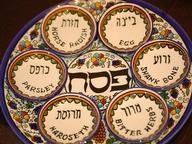Quiz Answer Key and Fun Facts
1. The six foods on the Seder plate are karpas, maror, beitzah, charoset, z'roa, and matzah. Karpas is a vegetable, such as parsley or celery, that sits on the left side of the Seder plate. We dip it in a certain liquid at the beginning of the Seder and eat it as an appetizer. In which liquid do we dip the karpas?
2. One of the four questions customarily asked by the youngest child at the beginning of the Seder is: "On other nights, we eat many vegetables. Why, on this night, do we eat bitter herbs?" The Hebrew term for the bitter herbs is 'maror'. Which herb, sometimes eaten as a condiment with beef, is often used for the maror?
3. Beitzah represents the festival sacrifice carried out in the Temple in Biblical times. Some interpretations also see it as a fertility symbol, or a symbol of the destruction of the Temple. What type of food is the beitzah?
4. Z'roa is a bone which represents the Passover sacrifice. Although some Jews use chicken bones for the z'roa, you're more likely to find a shank bone from an animal which was offered as a sacrifice in the days of the Temple before being roasted and eaten at home. Which animal is this?
5. Charoset is a sweet paste made up of various ingredients such as chopped dates, kosher wine, nuts and honey (although there are tons of different recipes out there). What does charoset represent?
6. The sixth item, the matzah, is made of flour and water - it's basically a very large cracker. It represents the exodus from Egypt, when Jews on the run had to eat unleavened bread instead of their usual bread, as they did not have enough time to wait for it to rise. It is customary to make a 'sandwich' out of pieces of matzah, charoset and maror, and eat it before the meal. What is the name for this sandwich?
7. After we've eaten the Seder meal, the children (or the youngest person present, if there are no kids) will hunt for the afikoman, or kidnap it and hold it for ransom. It is a piece of matzah that is broken in two. What does the word 'afikoman' mean?
8. As well as food, wine features very heavily throughout the Seder. At one point, we dip our fingers into our cups and spill drops of wine on the table. How many times do we do this, and what does it represent?
9. Which of these foods would you NEVER eat at a Seder meal?
10. Some Jews may put an orange on their Seder plate. Which group of people does the orange represent?
Source: Author
Kankurette
This quiz was reviewed by FunTrivia editor
agony before going online.
Any errors found in FunTrivia content are routinely corrected through our feedback system.

